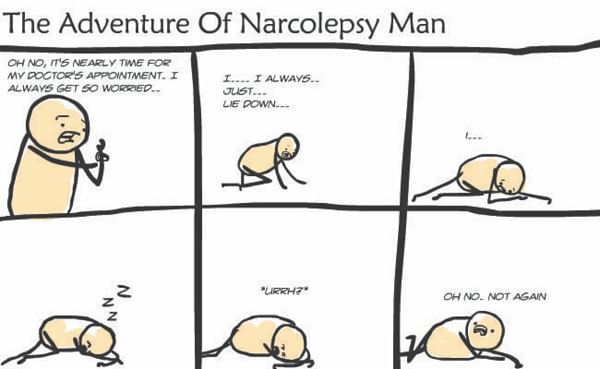| Home - Back Issues - The Team - Contact Us |
 |
| Volume 11 |Issue 45| November 16, 2012 | |
|
|
Health SLEEP Narcolepsy is a neurological disorder that affects the control of sleep and wakefulness. People with narcolepsy experience excessive daytime sleepiness and intermittent, uncontrollable episodes of falling asleep during the daytime. These sudden sleep attacks may occur during any type of activity at any time of the day. In a typical sleep cycle, we initially enter the early stages of sleep followed by deeper sleep stages and ultimately (after about 90 minutes) rapid eye movement (REM) sleep. For people suffering from narcolepsy, REM sleep occurs almost immediately in the sleep cycle, as well as periodically during the waking hours. It is in REM sleep that we can experience dreams and muscle paralysis – which explains some of the symptoms of narcolepsy.
Causes What Are the Symptoms of Narcolepsy
Symptoms of narcolepsy include: Cataplexy: This symptom consists of a sudden loss of muscle tone that leads to feelings of weakness and a loss of voluntary muscle control. It can cause symptoms ranging from slurred speech to total body collapse, depending on the muscles involved, and is often triggered by intense emotions such as surprise, laughter, or anger. Hallucinations: Usually, these delusional experiences are vivid and frequently frightening. The content is primarily visual, but any of the other senses can be involved. These are called hypnagogic hallucinations when accompanying sleep onset and hypnopompic hallucinations when they occur during awakening. Sleep paralysis: This symptom involves the temporary inability to move or speak while falling asleep or waking up. These episodes are generally brief, lasting a few seconds to several minutes. After episodes end, people rapidly recover their full capacity to move and speak. A physical exam and exhaustive medical history are essential for proper diagnosis of narcolepsy. However, none of the major symptoms is exclusive to narcolepsy. Several specialised tests, which can be performed in a sleep disorders clinic or sleep lab, usually are required before a diagnosis can be established. Two tests that are considered essential in confirming a diagnosis of narcolepsy are the polysomnogram (PSG) and the multiple sleep latency test (MSLT). The PSG is an overnight test that takes continuous multiple measurements while a patient is asleep to document abnormalities in the sleep cycle. A PSG can help reveal whether REM sleep occurs at abnormal times in the sleep cycle and can eliminate the possibility that an individual's symptoms result from another condition. The MSLT is performed during the day to measure a person's tendency to fall asleep and to determine whether isolated elements of REM sleep intrude at inappropriate times during the waking hours. As part of the test, an individual is asked to take four or five short naps usually scheduled two hours apart. Although there is no cure for narcolepsy, the most disabling symptoms of the disorder (EDS and symptoms of abnormal REM sleep, such as cataplexy) can be controlled in most people with drug treatment. Sleepiness is treated with amphetamine-like stimulants, while the symptoms of abnormal REM sleep are treated with antidepressant drugs. There has recently been a new medication approved for those who suffer from narcolepsy with cataplexy. This drug, called Xyrem, helps people with narcolepsy get a better night's sleep, allowing them to be less sleepy during the day. Patients with narcolepsy can be substantially helped – but not cured – by medical treatment. Lifestyle adjustments such as avoiding caffeine, alcohol, nicotine, and heavy meals, regulating sleep schedules, scheduling daytime naps (10-15 minutes in length), and establishing a normal exercise and meal schedule may also help to reduce symptoms. source: www.webmd.com |
||||
Copyright
(R) thedailystar.net 2012 |

